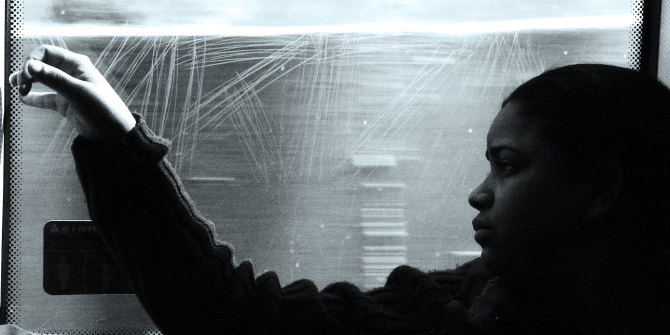In November 2021, Christiana Ajai-Thomas, a MSc student in Sociology at LSE, coined the term ‘sociology of doom’ to engage critically with how sociology, as a discipline that ‘disciplined’ our minds[1], has been harming black students: To study sociology leaves me hyperaware of my own oppression. Every reading, essay and class is traumatic,” she confesses in her stunning piece. I propose here to continue the conversation instigated by Ajai-Thomas by turning our attention from the student to the teacher. This is not to diminish the importance of the experiences shared by Ajai-Thomas, but rather to broaden the conversation to include those who, like her, enter the field of sociology only to encounter feelings of despair, untimely deaths, and well, hell. Because, it is true, to be black in an anti-black world is to live in “a constant state of rage.”[2]
I.
‘Do you hear me, do you feel me? We gon’ be alright’
– K. Lamar
Ajai-Thomas’ testimony echoes the very same challenge met by so many black scholars, community organisers, writers and artists working intimately on/in/against structures, practices, discourses and events of violence targeting black peoples.[3] As a potential road outside of doom, after decades of researching and writing about slavery and its afterlife in the United States, Saidiya Hartman recently decided to refocus her academic career from the scenes of subjection and death[4] to those of resistance and life in her most recent book Wayward Lives, Beautiful Experiments.
This leave us, however, with the impossible question of what happens to a discipline when those who are mostly affected by those structures, practices and events of violence leave the discipline. What would become of sociology if black students and scholars decide collectively to “walk ahead into the darkness, and [not] come back”?[5]
It is an impossible question because, of course, it suggests that leaving was ever an option—which it is not. Black thinkers have forced themselves, and are still trying to, claim space in the discipline, such as with the late recognition of W. E. B. Du Bois as one of its ‘founding fathers’.[6] Nevertheless, the practice of leaving harmful spaces, institutions and individuals is for many of us not only self-preservation as an ‘act of political warfare’[7] but also a refusal to be defined by the doom. This refusal is not a denial, a self-deception, of the multifarious ways in which premature death and state violence have conditioned black life, nor is it a complete rejection of what Du Bois calls the ‘half-truths’ of the social sciences. It is to walk through the minefield of our discipline with hesitation.
Indeed, as Myers reminds us in his study of Du Bois’ work, ‘[h]esitation is a creative force…[it] is a moment of both refusal and imagination…To hesitate is to break so those submerged ways of existing, of being, can be. Hesitance is to prepare to a freedom from restriction.’[8] It is to question the truth of Science and to engage with the poetics of Life. It is a battle against the demigod Reason and to embrace the living through its poetry, its making[9], which is to say how life evade generalisation, rules, laws, mathematics, etc.
Thinking poetically—with hesitance
is to dispute
the doom
as the inexorable
condition
of
black life.
Now, this path seems to have led us to a kind of turf war behind the closed doors of the academy, the so-called ‘culture war’. I believe that if there is any ‘war’ within the academy, it has little to do with what some labelled ‘freedom of speech’, and much more with what James Baldwin’s calls the “white men’s definitions.”[10] It is only when black students and scholars refused to be, to quote Baldwin again, a “fixed star” in the white man’s world,[11] that the whole world shakes and that walls, statues, flags, books and all the (il)legitimate symbols of power have to be shielded against (if not charge against) those who dare to imagine a world without them, a world outside of the doom.
II.
I am, however, left standing on an unstable ground when it comes to teaching the doom. In fact, if I must engage with institutional and structural violence that power enacts on black communities and individuals (let’s say with Du Bois’ sociology), how do I prevent myself from perpetuating the institutional harm that black students face, when what the University teaches is that all we are is oppressed, underachieving, poor, victims of state-sanctioned violence?
That we were not welcomed here and are still not; that we live in an anti-black world; we have no future, and no real past as our ancestors never stepped into History and that we cannot produce scientific knowledge (because our skin colour makes us biased!), only be objects of study. We are, as Du Bois famously presented it, a problem.[12] This is the story that is told, and retold, year after year, cohort after cohort, in the classroom.
In the end, it could be that, for black peoples, sociology-as-doom has nothing to do with the panacea and everything to do with the pharmakon, i.e. a medicine that acts as both cure and poison.[13] Therefore, teaching the doom is essential in the sense that it might, in some way, maybe, help some of them as it helps me to see through the Veil. However, I want to suggest that students have their own agency and can decide for themselves what they need to know, when and from whom. More importantly, they can say no and leave.
The practice of leaving should not be read as an end because, as I said earlier, leaving is never really an option. Black students are essential to sociology as much as sociology can be to them. One could easily notice how their experience, knowledge, and more importantly, their imagination (re)make the discipline. Nevertheless, refusing to be a problem and to be defined by the doom should be presented to them as an opportunity to make the terms by which they engage with or against the discipline, if not the university. In more concrete terms, as educators, we can offer to black students a way to participate in a session without physically being present in the classroom.[14] Leaving could also mean shifting the focus of a discussion in the class or in the curriculum from one of death and subjugation to one of life and resistance, as Hartman did. Instead of engaging with black lives as a problem (that need to be resolved through data, figures, graphs, statistics, etc.), we may discuss with our students about the poetics of black lives, in other words, how joyful and hopeful black futures can, and should, be.
Finally, by approaching sociology as a pharmakon, we can possibly answer, at least partially, the serious question of whether the ‘master’s tools can dismantle the master’s house.’[15] Indeed, this interrogation has been haunting any project of epistemic justice and paralysing the discipline in that it is intended to be a critique of power while being implanted in the grounds irrigated by it—the academy. In other words, if sociology can provide black peoples with the ‘tools of the master’, it is not certain that it will be able to topple his house, even worse, it may strengthen his hold on black consciousnesses as suggested in Ajai-Thomas’ piece. Besides, I do not think that ‘building our own table’—such as Sara Ahmed’s political and academic project—completely resolves this tension as all in all, it is set at the theoretical level, not material one, leaving out the details of the real costs (e.g., financial resources, human labour, etc.) of such an endeavor.
III.
‘Ain’t no devil in my melanin,
I’m a rebel with a felony’
– Crystal Axis
I do not wish to consolidate the ground on which I am now standing—its mushiness pushes me to take a break and think, it guides me into the room of my imagination—but I do not want anyone to fall with me into the doom. While I want to participate in the various projects of reparation in the discipline, such as Gala Rexer’s reparative writing or Gurminder K. Bhambra’s connected sociologies, I am also cautious of ‘good intentions.’ For instance, so many political, economic and social projects started with the fact that black communities needed to be ‘cared for’ or ‘repaired’ and ended up in strengthening the grip that patriarchy, white supremacy and racial capitalism have on them—one could think of the cannibalisation by the academy of Black feminist thought as shown with the depoliticisation (almost de-blackfication) of intersectionality.[16]
Therefore, reparatory projects in sociology, as in other disciplines, should be led by those for who harm and violence are not (only) research interests added on their academic profile. In fact, acts and language of care can indeed be harmful. What I want to suggest, while this dark cloud over my head is passing through, is that teaching repair is not about ‘saving’ black peoples but about dreaming, with them, of freedom and justice. It is not to teach a knowing, nor a questioning, that dictate a certain grammar of black life, but it is to invite students into exploring with us all those wayward lives that have been escaping the sociologist gaze and, yet, still, breathe—against all odds, despite science and its manipulated truths.
References
[1] McKittrick, K. (2021). Dear Science and other stories, p.45
[2] Baldwin, J. (1961). “The Negro in American Culture” a group discussion. Retrieved from https://www.youtube.com/watch?v=jNpitdJSXWY
[3] I thank here Babette May for hinting to the fictitious and prescribed homogeneity of the term ‘black people’. By referring to black peoples in this text, I am highlighting the variety of experiences, histories, cultures, geographic (dis)locations, and other features of black communities.
[4] Hartman, S. (1997). Scenes of subjection: Terror, slavery, and self-making in nineteenth-century America. Oxford University Press.
[5] Le Guin, U. (2004). The Ones Who Walk Away From Omelas. In The Wind’s Twelve Quarters. Harper Perennial.
[6] This move has been criticised by some, including Joshua Myers who question the canonisation of W. E. Du Bois into Black Study programmes. See Myers, J. (2023). Of Black Study. Pluto Press.
[7] Lorde, A. (2017). A Burst of Light: and Other Essays, p.181. Dover.
[8] Myers, J. (2023). Of Black Study, p.15. Pluto Press.
[9] Poetics comes from the Greek poiein, which means ‘to make’.
[10] Baldwin, J. (2017). The Fire Next Time, p. 17.
[11] Baldwin, J. (2017). The Fire Next Time, p. 17.
[12] Du Bois, W. E. B. (2007). The Souls of Black folk, p.7. Oxford Classics.
[13] Mbembe, A. (2016). Politiques de l’inimité, p.16. La Découverte.
[14] Of course, this can be extended to other marginalised groups, but the focus I have in this piece is on Black students/teachers.
[15] Lorde, A. (2018). The Master’s Tools Will Never Dismantle the Master’s House. Penguin.
[16] Bilge, S. (2013). INTERSECTIONALITY UNDONE: Saving Intersectionality from Feminist Intersectionality Studies. Du Bois Review: Social Science Research on Race, 10(2), 405-424. doi:10.1017/S1742058X13000283




